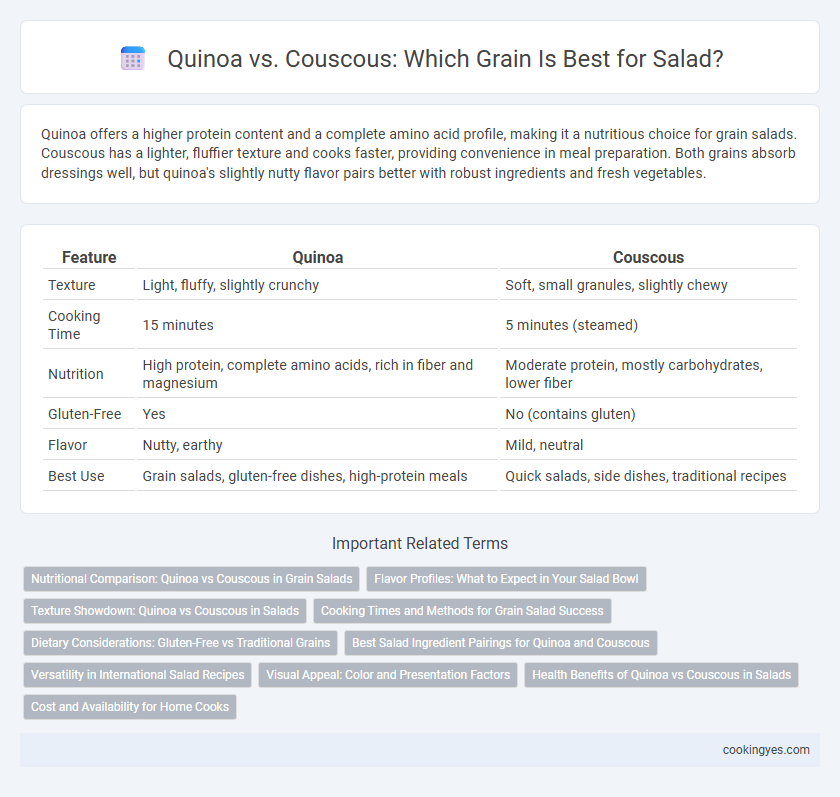Quinoa offers a higher protein content and a complete amino acid profile, making it a nutritious choice for grain salads. Couscous has a lighter, fluffier texture and cooks faster, providing convenience in meal preparation. Both grains absorb dressings well, but quinoa's slightly nutty flavor pairs better with robust ingredients and fresh vegetables.
Table of Comparison
| Feature | Quinoa | Couscous |
|---|---|---|
| Texture | Light, fluffy, slightly crunchy | Soft, small granules, slightly chewy |
| Cooking Time | 15 minutes | 5 minutes (steamed) |
| Nutrition | High protein, complete amino acids, rich in fiber and magnesium | Moderate protein, mostly carbohydrates, lower fiber |
| Gluten-Free | Yes | No (contains gluten) |
| Flavor | Nutty, earthy | Mild, neutral |
| Best Use | Grain salads, gluten-free dishes, high-protein meals | Quick salads, side dishes, traditional recipes |
Nutritional Comparison: Quinoa vs Couscous in Grain Salads
Quinoa contains higher protein content, essential amino acids, and is gluten-free, making it a superior choice for grain salads targeting nutrition. Couscous, derived from semolina wheat, offers lower protein levels and contains gluten but provides a lighter texture and quicker cooking time. Both grains supply fiber, but quinoa delivers additional minerals like magnesium and iron, enhancing the salad's overall nutritional profile.
Flavor Profiles: What to Expect in Your Salad Bowl
Quinoa offers a slightly nutty, earthy flavor with a chewy texture that enhances the freshness of vegetables in grain salads. Couscous has a mild, neutral taste and a light, fluffy texture, making it an excellent base for bold, flavorful dressings and spices. Choosing quinoa brings a distinctive protein-rich bite, while couscous delivers a versatile, absorbent grain ideal for complementing robust herbs and tangy ingredients.
Texture Showdown: Quinoa vs Couscous in Salads
Quinoa offers a light, fluffy texture with a slight crunch from its germ, making it ideal for salads that require a delicate bite and a nutty flavor. Couscous provides a denser, softer texture with a subtle chew, which absorbs dressings well and adds heartiness to grain salads. Choosing between quinoa or couscous depends on whether you prefer a crisp, distinct grain or a smooth, absorbent base in your salad's texture profile.
Cooking Times and Methods for Grain Salad Success
Quinoa cooks rapidly, typically requiring 15 minutes of simmering to achieve a fluffy texture ideal for grain salads, while couscous needs only about 5 minutes of steaming or soaking in hot water for light, quick preparation. Quinoa's method involves rinsing to remove bitterness before cooking, producing a nuttier flavor and distinct grain separation, whereas couscous expands by absorbing hot liquid, resulting in a softer, more delicate texture. Choosing between quinoa and couscous hinges on desired salad texture and preparation time, with quinoa offering a protein-rich option and couscous delivering convenience and speed.
Dietary Considerations: Gluten-Free vs Traditional Grains
Quinoa is naturally gluten-free, making it an ideal grain alternative for individuals with celiac disease or gluten sensitivity when preparing grain salads. Couscous, derived from durum wheat, contains gluten and may trigger reactions in those avoiding gluten-containing foods. Choosing quinoa over couscous enhances the salad's dietary versatility while supporting gluten-free lifestyle requirements.
Best Salad Ingredient Pairings for Quinoa and Couscous
Quinoa pairs exceptionally well with ingredients like cherry tomatoes, cucumbers, fresh herbs (mint, parsley), avocado, and citrus dressings, enhancing its nutty flavor and fluffy texture in grain salads. Couscous complements Mediterranean flavors such as roasted vegetables, feta cheese, olives, dried fruits (apricots, raisins), and a drizzle of olive oil, creating a tender and flavorful salad base. Both grains offer versatile options, but quinoa's higher protein content and slightly crunchy texture contrast with couscous's softer consistency, influencing ingredient pairings.
Versatility in International Salad Recipes
Quinoa offers greater versatility in international salad recipes due to its nutty flavor and ability to absorb a wide range of dressings and ingredients, making it ideal for Mediterranean, South American, and Middle Eastern dishes. Couscous, a staple in North African cuisine, provides a light, fluffy texture that complements robust spices and vegetables but is less adaptable to diverse flavor profiles. Both grains enrich salads with unique textures and nutrients, yet quinoa's gluten-free status and higher protein content expand its culinary use across global salad recipes.
Visual Appeal: Color and Presentation Factors
Quinoa's vibrant tri-color variety, including red, black, and white grains, enhances the visual appeal of grain salads by providing a dynamic and textured presentation. Couscous, typically pale yellow and uniform in size, offers a smoother, more consistent base that highlights colorful vegetables and herbs layered on top. The contrasting colors and shapes between quinoa and couscous significantly influence the overall attractiveness and perceived freshness of the salad.
Health Benefits of Quinoa vs Couscous in Salads
Quinoa offers higher protein content and a complete amino acid profile compared to couscous, making it a superior choice for nutrient-dense grain salads. Rich in fiber, magnesium, and antioxidants, quinoa supports digestive health and helps regulate blood sugar levels. Couscous, mainly composed of refined wheat, provides fewer vitamins and minerals, resulting in a less nutrient-rich option for health-focused salads.
Cost and Availability for Home Cooks
Quinoa is generally more expensive and less widely available than couscous, making couscous a budget-friendly and accessible option for home cooks. Couscous is often sold in bulk at grocery stores and supermarkets, ensuring consistent availability and lower prices. For affordable grain salads, choosing couscous can significantly reduce cost without compromising ease of preparation.
Quinoa vs Couscous for Grain Salad Infographic

 cookingyes.com
cookingyes.com